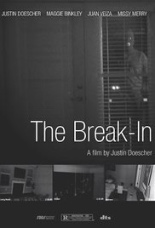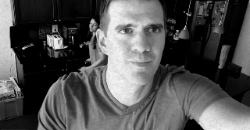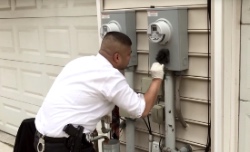
 Based on the evidence that is The Break-In, we may assume that do-it-all filmmaker Justin Doescher saw Paranormal Activity — and perhaps even one or more of its sequels — and said aloud to himself, “Heck, I can do that!”
Based on the evidence that is The Break-In, we may assume that do-it-all filmmaker Justin Doescher saw Paranormal Activity — and perhaps even one or more of its sequels — and said aloud to himself, “Heck, I can do that!”
But he cannot. The Break-In is a rank-amateur, found-footage thriller that deserves to stay lost.
Built upon the flimsy-even-for-fiction premise that Jeff Anderson (Doescher, who also wrote, directed and produced) has a cool new phone and feels the need to record his every move, the movie presents itself as a week’s worth of police evidence. With a rash of recent burglaries plaguing the neighborhood, Jeff installs a security system to better protect his fiancée, Melissa (Maggie Binkley), and their unborn child. Cameras keep tabs on exactly four rooms: the kitchen, the bedroom, the living room and the “lounge room” (known to the rest of the civilized world as “a lounge”).
 Whenever the movie’s POV shifts away from Jeff and his goddamn phone (not often enough) and to these security cams, the screen denotes which room we’re looking at, presumably in case viewers are unable to process obvious visual cues that a bed indicates a bedroom; a refrigerator means a kitchen; and so on. But mostly, The Break-In is Jeff yammering away as he eats dinner, shops for a crib, takes out the recycling — you know, the special moments to preserve for Baby!
Whenever the movie’s POV shifts away from Jeff and his goddamn phone (not often enough) and to these security cams, the screen denotes which room we’re looking at, presumably in case viewers are unable to process obvious visual cues that a bed indicates a bedroom; a refrigerator means a kitchen; and so on. But mostly, The Break-In is Jeff yammering away as he eats dinner, shops for a crib, takes out the recycling — you know, the special moments to preserve for Baby!
Whether he is by himself or with “my boy”/best friend/next-door neighbor/fellow athletics-obsessed meathead man-child Steve (J.P. Veizaga, 10 Rules for Sleeping Around); with Melissa, who applies glitter to her eyelids, yet works as a teacher and not a stripper; or with the buzz-cut Det. Garcia (Ted Fernandez, at once the standout performer and the screen’s least convincing police detective), Jeff records it all.
 The way in which Doescher tells his story is maddening: He speaks all the exposition, as if he were reading stage directions from a script. Despite the writer’s axiom of “show, don’t tell,” Doescher figures, “Hey, why not both?” In essence, he narrates actions that need no narration, shares information that needs no sharing and, most damning, externalizes his internal thoughts, as if he does not trust his audience to know that, for example, seeing Melissa stretching in workout clothes and sunglasses on the front porch suggests that a run either has happened or is about to happen.
The way in which Doescher tells his story is maddening: He speaks all the exposition, as if he were reading stage directions from a script. Despite the writer’s axiom of “show, don’t tell,” Doescher figures, “Hey, why not both?” In essence, he narrates actions that need no narration, shares information that needs no sharing and, most damning, externalizes his internal thoughts, as if he does not trust his audience to know that, for example, seeing Melissa stretching in workout clothes and sunglasses on the front porch suggests that a run either has happened or is about to happen.
And to say anything “happens” in the no-budget microindie is being awfully kind. On occasion, we get a glimpse of some mysterious figure in the corner of the frame or far in the background, yet what all that leads up is no mystery: It’s right there in the title! How a found-footage project possibly could capture a dream sequence, however, there’s your mystery.
Many a found-footage film falls flat, but The Break-In usurps the likes of The Gallows and 8213: Gacy House as the subgenre’s worst. If a sports bar could make a movie, the result would be The Break-In. And yet it’s all out of cheese fries, so what’s the point? —Rod Lott
